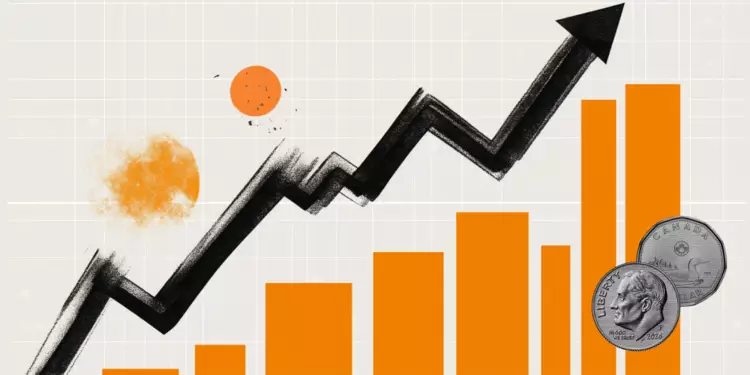The recent climb of the USD/CAD exchange rate to approximately 1.4105 during the early Asian session on Thursday marks a pivotal moment influenced by various geopolitical maneuvers and economic data releases. What stands out in this market shift is the announcement by President Donald Trump regarding a temporary 90-day freeze on the implementation of reciprocal tariffs, a move that has not only bolstered the US Dollar (USD) but also adds elements of intrigue and volatility into the foreign exchange market. The intricate ties between tariffs, currency exchange, and trade negotiations have come into sharp focus, revealing the fragility and complexity of the global economic landscape.
The Presidential Tariff Pause: Stability or Uncertainty?
Trump’s directive to postpone new tariffs for most US trade partners has ignited optimism among traders, with analysts like Mark Hackett describing it as a potentially stabilizing force amid a market fraught with uncertainty. While some stakeholders breathe a sigh of relief, viewing this pause as evidence of productive dialogue between the United States and its trading partners, it raises questions about the long-term implications of such a strategy. Does a temporary halt signal genuine progress, or is it merely a tactical pause in a broader trade-war narrative?
Market responses suggest a slight shift in sentiment, albeit one tempered by the overshadowing effects of forthcoming economic reports, particularly the Consumer Price Index (CPI) for March. Traders are compelled to adjust their strategies in response to both political maneuvers and the consequential economic indicators that arise from them.
The Impact of Inflation on Currency Value
As the US CPI report takes center stage, attention will inevitably pivot towards inflation figures. Expectations are pointing to a year-on-year increase of 2.6% in headline CPI, with core CPI likely rising by 3.0%. These figures are not just numbers; they are signals of economic health that can shape monetary policy decisions. While conventional wisdom states that high inflation can erode a currency’s value, the current landscape suggests a more nuanced interpretation.
Contrary to historical norms, rising inflation often prompts central banks to increase interest rates, attracting foreign investment and thus boosting demand for the local currency. This cyclical relationship highlights a shift in the paradigm; while inflation worries traditionally dampened currency prospects, today’s investors might view such inflation as a beacon for potential capital inflows. Consequently, the intricate dynamics of lieu currency valuation lend weight to the intricacies surrounding the USD/CAD pairing.
Crude Oil: The Loonie’s Lifeblood
Inextricably linked to the performance of the Canadian Dollar (CAD) is the price of crude oil, the country’s largest export commodity. Recent recoveries in oil prices may lift the CAD further as heightened demand generates a robust environment for the currency. Canada’s dependency on oil revenues accentuates the sensitivity of the CAD to fluctuations in global oil prices — a dynamic that serves as both an opportunity and a risk for traders.
The correlation between crude prices and currency value highlights the significant role that market sentiment plays in the forex landscape. Thus, as oil prices remain volatile, the Loonie’s trajectory may reflect broader investor sentiments, influenced by not just economic data, but geopolitical events and global demand dynamics.
The BoC’s Balancing Act
The Bank of Canada’s (BoC) monetary policy is yet another layer influencing the CAD’s valuation. With a steadfast commitment to keeping inflation within a target range of 1-3%, the BoC utilizes interest rate adjustments as its primary tool. A relatively higher interest rate environment is typically seen as bullish for the CAD, providing it with an edge against other currencies in the forex market.
As traders look ahead to the BoC’s decisions in response to changing economic conditions, there is an underlying tension between macroeconomic stability and the potential need for intervention. The BoC’s ability to execute quantitative easing or tightening measures signals the central bank’s dexterity in navigating an intricate economic landscape marked by uncertainty.
Understanding Market Sentiment: Risk-On vs. Risk-Off
Market sentiment plays a crucial role in shaping foreign exchange rates, particularly for currencies like the CAD that are linked closely to commodity prices. During risk-on periods, when investors lean towards more aggressive asset classes, the CAD may rally as risk appetite increases. Conversely, during times of heightened uncertainty, a risk-off sentiment could prompt a capital flight towards safer assets, negatively impacting the CAD.
Understanding this sentiment is essential for traders as they position themselves strategically around economic data releases and geopolitical events. In the evolving landscape influenced by tariffs, inflation, and global market dynamics, maintaining a pulse on market sentiment could offer invaluable insights for forecasting future movements in the USD/CAD exchange rate.

